It’s my tendency to appreciate native bird species more than I do those that have been introduced but right or wrong I tend to make an exception for California Quail.
Native only to the Pacific coast from British Columbia down to Baja they were first introduced into Utah in the area of Salt Lake City’s Ft. Douglas in 1869 by General John Gibbon (he was a fascinating character in Civil War and western history in his own right) where they have thrived and even spread. I regularly see these saucy little quail in my neighborhood and yard near the Jordan River and they occasionally nest near and beneath my backyard storage shed.
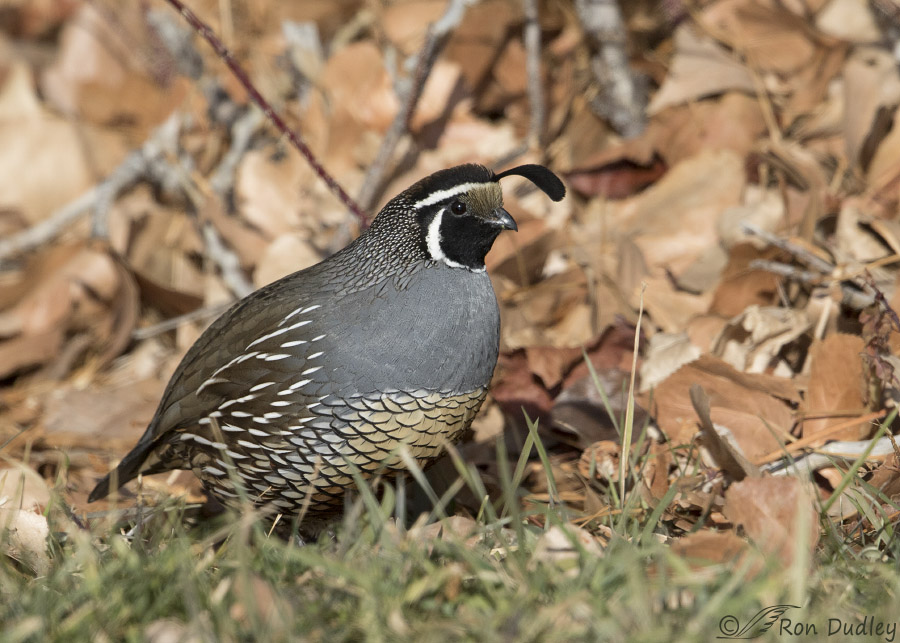
1/3200, f/6.3, ISO 500, Canon 7D Mark II, Canon EF 500mm f/4L IS II USM + EF 1.4 III Extender, not baited, set up or called in
I tend to avoid photographing them in obviously urban and suburban settings but three days ago I found a large and cooperative covey of adult males and females along the Jordan River Parkway and that setting looked just a little more natural so of course I fired away with my camera.
Males are boldly patterned with a distinctive black, comma-shaped topknot hanging forward in front of their face.
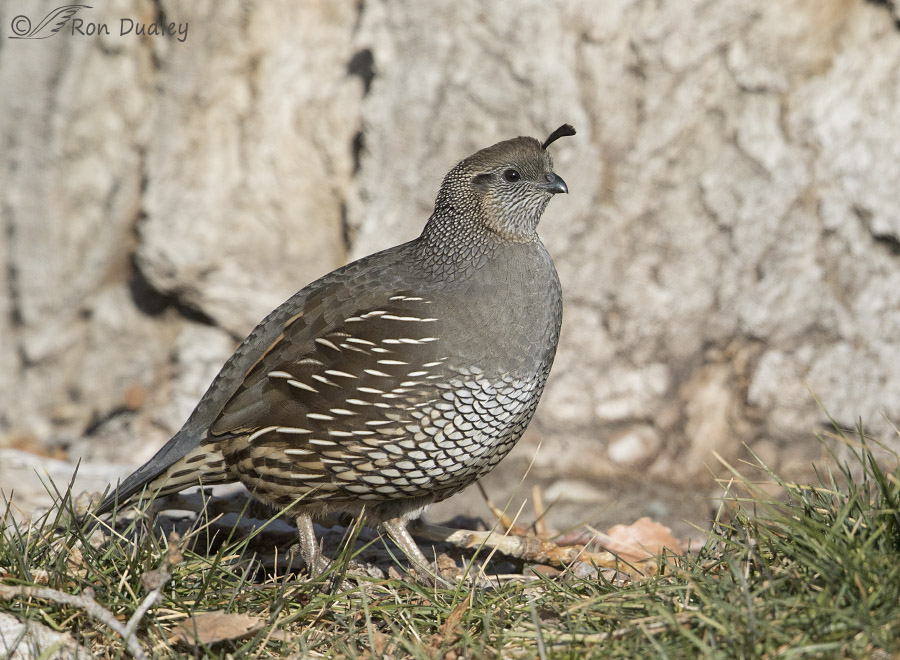
1/5000, f/6.3, ISO 500, Canon 7D Mark II, Canon EF 500mm f/4L IS II USM + EF 1.4 III Extender, not baited, set up or called in
Adult females are somewhat similar to males, though duller and browner. Their heads are entirely brownish gray and lack the bold markings of the male and they don’t have the distinctive chestnut patch on the belly.
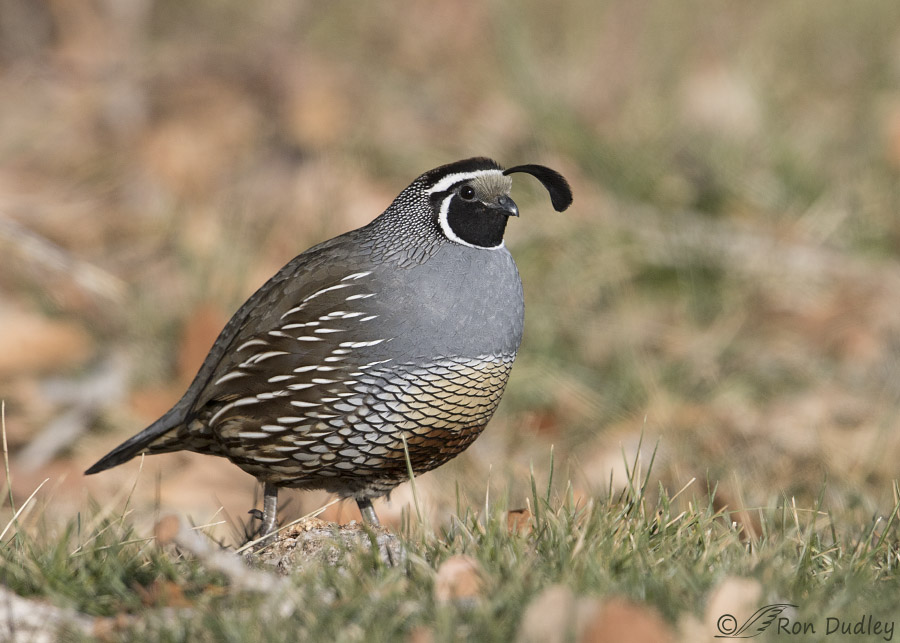
1/2500, f/6.3, ISO 500, Canon 7D Mark II, Canon EF 500mm f/4L IS II USM + EF 1.4 III Extender, not baited, set up or called in
I got a few shots of a male where the background wasn’t so close to the bird. The topknot is actually a cluster of 6 forward-facing black feathers (plumes) whose function is apparently still debated, especially because adults of both sexes have them.
The somewhat similar but more southerly residing (in Utah) Gambel’s Quail lacks the black scaling on the underparts and their dark belly patch is black rather than cinnamon.
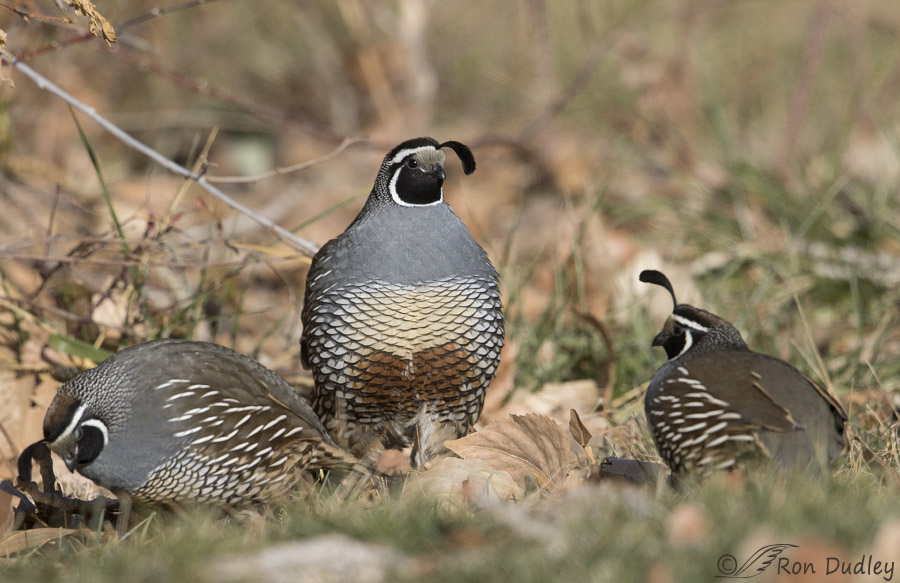
1/3200, f/6.3, ISO 500, Canon 7D Mark II, Canon EF 500mm f/4L IS II USM + EF 1.4 III Extender, not baited, set up or called in
Generally I’m not a fan of multiple birds in my photos but for several reasons this series turned out to be a bit of an exception. I like the symmetry and separation of the three males in the photo and the sharp focus on the primary subject in the middle.
But mostly I like the series because the center male put on a little show for me. It was only a brief wing flap but it’s something I’ve rarely if ever photographed in this species so I was happy to get it.
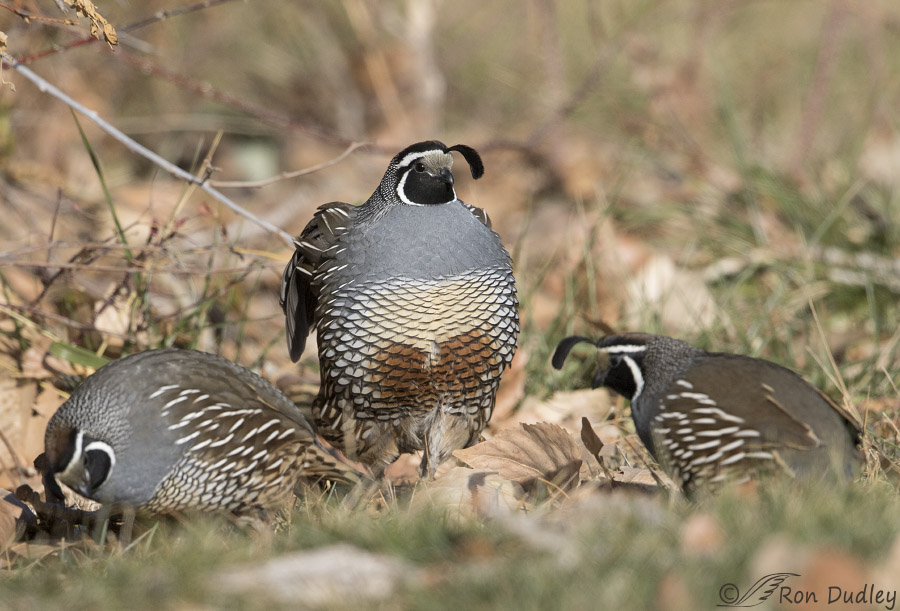
1/3200, f/6.3, ISO 500, Canon 7D Mark II, Canon EF 500mm f/4L IS II USM + EF 1.4 III Extender, not baited, set up or called in
He puffed up his chest…
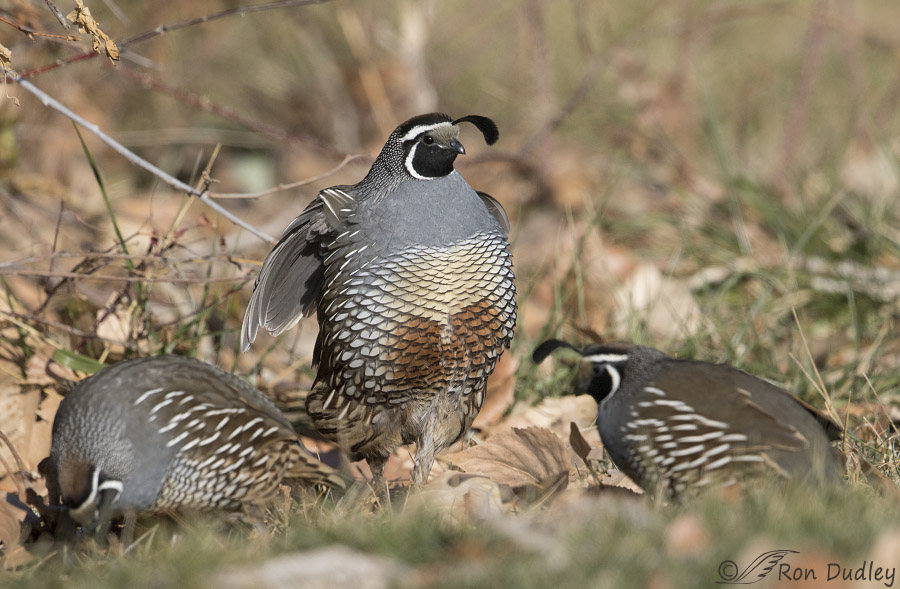
1/4000, f/6.3, ISO 500, Canon 7D Mark II, Canon EF 500mm f/4L IS II USM + EF 1.4 III Extender, not baited, set up or called in
and turned his head to give me better eye contact as he began to…

1/3200, f/6.3, ISO 500, Canon 7D Mark II, Canon EF 500mm f/4L IS II USM + EF 1.4 III Extender, not baited, set up or called in
expand his primaries and flap although he never did fully extend his wings. This was another one of those times I was glad to have enough shutter speed to completely avoid motion blur.
As spring breeding season approaches California Quail coveys dissolve and the adults adopt a variety of complex mating strategies including social monogamy, sequential polygamy and simultaneous polyandry. So here in northern Utah beginning in about late March they’re generally not seen in large groups like these birds were.
If you’re interested in seeing and hearing these quail as I often see them in my own back yard in spring and early summer you might want to watch this video clip that includes interesting scenes of their busy family life. One of my life’s joys is to be sitting at my computer as I’m preparing one of my blog posts and have male California Quail calling from a tree outside my window in full view and only about 10′ from my face.
Now that’s some real inspiration.
Ron


Fantastic series Ron!
Charlotte
These are fantastic shots. I love quail.. unless they erupt around me in a field where I didn’t see them until I was right on top of them. Then it feels like I stepped on a landmine and the world is ending. I think I hear them laughing as they fly away.
Late to this post, but just FYI, California quail are here in N. Arizona, too. It’s not unusual to have to stop on our dirt road to let the family cross safely. I keep trying to convince Jack that he CAN catch them, but he really enjoys watching them fly, scurry or even saunter away from him to a safer hideout. He might be too old to learn new tricks, but I’ll admit it’s pretty funny watching him watch them.
And EC come on. How many of us are productive looking out a window where there are cool birds? LOL!
Ron, what a treat to see these incredibly interesting birds. We see them in our back yard and quite enjoy seeing those little ones running after the male and female adults. We have some wooden steps that they run up and down to their nests in the pine trees. They always run and scratch in the dirt…so cute!!!
I also enjoyed the video and the little ones. It does not take long for the chicks to scratch just like the adults.
Thanks again…you made my day!!!
Glad to hear that, Alice. Thanks.
Beautiful shots Ron. We get them in our yard now and then.
Thank you, Jean.
Thanks for thes series of beautiful quail. If you recall, I enjoy coveys of Gambel’s Quail in my backyard and neighborhood. They seem to rotate from yard to yard and the wash behind our houses. Regarding the topknot, they seem to change position around breeding season. Love the babies!
Thank you for yet another beauty wot I will probably never see. That top notch they carry would send me crazy though, much like an errant lock of hair.
I suspect that if I looked out my window to see these charmers I would get even less ‘achieved’ than I do now – if that was possible.
Yeah, It’s hard to look at my computer when there are birds a few feet away from me if I just turn my head. Thank, EC.
There is a population of California quail around Boise, Idaho. I rescued one from a freeway offramp once, where it had been struck by a vehicle. They were introduced ~100 years ago, according to http://boisestatepublicradio.org/post/idaho-s-only-native-quail-almost-gone#stream/0.
Martha, In the last 150 years or so they’ve actually been introduced into quite a few areas where they weren’t indigenous.
Hi Ron,
I think you short changed Washington state as Birds of North America says:
The indigenous range of this species includes the west coast of North America from British Columbia through Baja California Mexico.
However their numbers have certainly decreased over the last 30 years. One irony is that in Mason County which includes the lower Hood Canal and parts of the Olympic Mountains, the Native California Quail have been completely driven out by the introduced Mountain Quail.
You’re right, I did, John. I’ll edit my post.
These photos are nice. What gets me about the male who posed for you is that it looks to me like his plume is turned to the side, and a bit droopy, instead of the upright, forward-facing plume I expect. Even though I grew up in southern California, and did some traveling about when I was in college, I am not certain I’ve ever seen a California Quail. If I did, it was so long ago that I don’t remember. However, we get the Gambel’s Quail here, and periodically I get to see them briefly. A few weeks ago we startled a whole covey of them when we were going into a pictograph site at the park. It’s always fun to see them.
Susan, Gambel’s Quail are beautiful birds too. The only time I ever see them is on trips to southern Utah and it’s been a while.
“social monogamy, sequential polygamy and simultaneous polyandry”. Now there is a mouth full! We have lots of these guys in the S. Cal high desert. Love it when they cooperate and especially when the males stand sentry and call! Thanks for the post Ron! PS, I would have to say that if there are rumors out there that allege these birds are not present in California, I will vouch that they are, and numerous.
That’s good news about your quail, Frank. Perhaps the problems with them in your state are regional.
And yes, that one partial sentence was a mouthful, especially if you try to say it fast three times!
Frank, Here’s the link Marina was referring to. She’s right – apparently they’ve disappeared from the San Francisco area:
https://ww2.kqed.org/science/2017/10/26/the-lonely-call-of-the-last-san-francisco-quail/
Great images Ron, very beautiful bird, both male and female.
Marina is correct about the demise of the CA Quail in CA, and especially around San Fransisco. Primarily it seems that cats, raccoons and avian predators are considered the responsible culprits. Sad!
I am truly glad they are doing well in your neck of the woods.
They seem to be holding their own here, Dick, although efforts by DWR (trapping and relocation) to increase their range haven’t had great success in many areas.
There’s a small covey where we walk. Love seeing them here so sharp and close(lens anyway). Happy winter solstice.
I wish you the same, Arwen. I’ve always thought it interesting that as the sun begins to stay up longer now our temps continue to plummet for another couple of months.
Yep – I’ve also noted that over time – worst weather comes after the winter solstice!
Great pictures as always .. I read somewhere that California quails are virtually gone in California … read it on an Audubon link . So glad they are doing good in Utah.
Hmmm, I didn’t know that about these birds in CA, Marina. That’s ironic since this species is their state bird.
Beautiful little birds! Glad you could capture even the trio……. Video is great with the one hen having a HUGE clutch. I would not think to look for them in trees!
Glad you could capture even the trio……. Video is great with the one hen having a HUGE clutch. I would not think to look for them in trees!  I’m grinning ear to ear on this -5 morning. Have 6″ to 8″ of “fluffy stuff” over some wetter snow that will blow “nicely” when the wind comes later….
I’m grinning ear to ear on this -5 morning. Have 6″ to 8″ of “fluffy stuff” over some wetter snow that will blow “nicely” when the wind comes later….
Judy, clutch size can be as large as 21 though that can be a result of “egg dumping” by multiple females.
25° F. here right now with about an inch of new snow. Looks like it’s about to clear but we could get more white stuff later in the week.
“Blow” and “nicely” are two words I NEVER used together when I lived in MT…
No, I certainly don’t use those 2 together except to be “smart”………..:)
Thanks for the chance to view these wonderful birds that I haven’t seen in person. (Yet!) They remind me of the Bob Whites I used to see and hear in Eastern Massachusetts when I was growing up. I haven’t seen one in these populated parts for many years but I have heard a few calling. Great photos once again!
Ha, we’re even, Joanne. I’ve never seen a Bob White and probably never will.